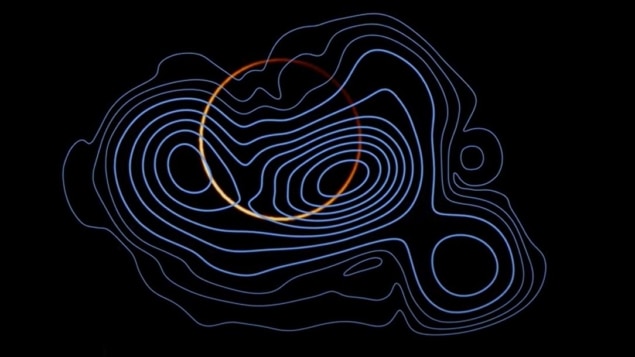
A sharp ring of light created by photons racing around the back of a supermassive black hole has been spotted by researchers working on the Event Horizon Telescope (EHT). The observation confirms a prediction of Einstein’s general theory of relativity and sheds further light on the mass of the black hole and the powerful jet of material that emanates from the supermassive object.
The EHT is a global array of radio telescopes, which when combined have an aperture wide enough to resolve the immediate surroundings of supermassive black holes. In 2019 EHT scientists produced the first ever image of the glowing disc of gas and “shadow” surrounding the supermassive black hole M87*. This object is at the heart of the Messier 87 galaxy and is thought to be about 7 billion times more massive than the Sun. The EHT was then pointed at the supermassive black hole at the centre of the Milky Way and an image of that object’s disc and shadow was released earlier this year.
Now EHT researchers led by Avery Broderick of Canada’s Perimeter Institute for Theoretical Physics and University of Waterloo have revisited their observations of M87* in search of a sharp ring of light created by photons that do a half-orbit around the back of the black hole before travelling to Earth. This ring is predicted by general relativistic magnetohydrodynamical simulations of the region surrounding M87* but could not be seen because of the bright disc of diffuse light created by photons that travel directly to Earth.
Seeing the fireflies
“We turned off the searchlight to see the fireflies,” says Broderick, adding, “We have been able to do something profound – to resolve a fundamental signature of gravity around a black hole.” The team did this using a new imaging algorithm that they added to THEMIS – an analysis framework that helps researchers understand EHT observations.
Team member Hung-Yi Pu of National Taiwan Normal University says that the new algorithm allows the collaboration to “peel off” elements of an EHT image so that “the environment around the black hole can then be clearly revealed”.

Building a planet-sized telescope
As well as observing the photon ring, the team found evidence for a powerful rotating jet of material being ejected from the region of the black hole. The latter observation confirms the theoretical prediction that the rotation of the black hole creates a powerful outflow of material. This latest analysis combined with previous observations has also allowed the team to give the best value so far for the mass of M87*, pegging it at 7.13 ± 0.39 billion solar masses.
Theory predicts that more rings should exist around M87*, each corresponding to photons doing different orbits around the black hole. The team believes that it should be able to refine its analysis to see at least one more of these rings.
The research is described in The Astrophysical Journal.



